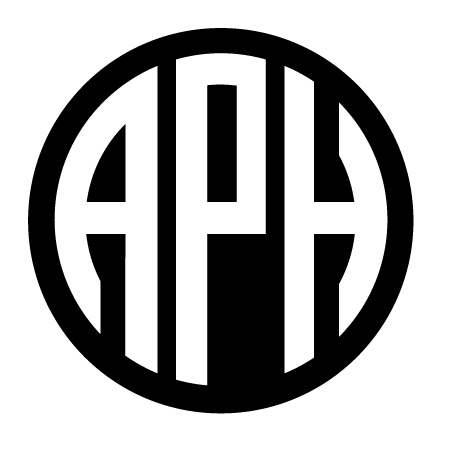
APH News
Your monthly link to the latest information on the products, services, and training opportunities from the American Printing House for the Blind.
August 2011
Exciting New APH Products Announced!
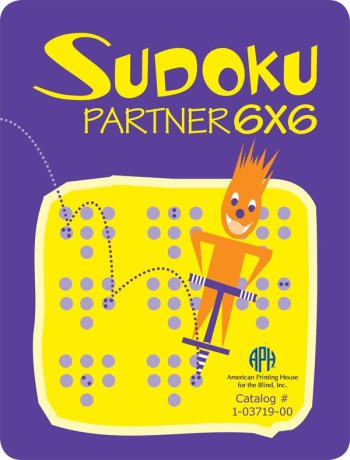
Read on to learn about these new products – now available!
- Sizzlin’ Summer Savings Sale
- New Downloadable Manuals Available
- Sudoku Partner 6×6
- EZ Track Calendar, 2012
- APH Braille Book Corner
"Running Strong Since 1858" Gets Closer to the Starting Gate
If there is such a thing as a sure bet, it’s betting that you won’t want to miss this year’s APH Annual Meeting. We’ve been “Running Strong Since 1858” to get ready for this one, and you will definitely want to be here!
Joining keynote speaker Annette Reichman in our stable of presenters will be several APH staff members, product consultants, and other guests. You’ll have a chance to provide input on products in development and learn about new products such as Sense of Science: Astronomy and the APH Talking PC Maps. You’ll get up to the minute information on accessible tests, the changes to our Louis database, and more! We’ll have a paddock full of poster sessions for your perusal and enjoyment, and the stars will shine for the annual APH InSights Art awards banquet and the Hall of Fame Induction ceremony.
So, how do you sign up for this event? Well, we outran the snails delivering our traditional paper invitations, so you will soon receive an email from APH inviting you to be a part of the 143rd Annual Meeting extravaganza. Just click on that email and you’ll find everything you need to know about registering online. If you don’t receive an email and would like to register, you can find a registration link on the APH website at http://sites.aph.org/annual-meeting-2011/.
At the Gate:
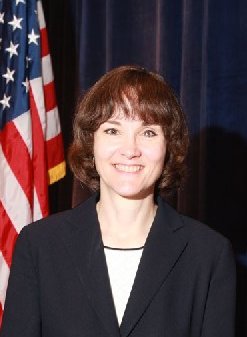 Annette Reichman
Annette ReichmanKeynote Speaker
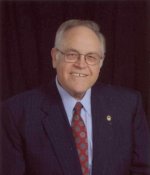 Ralph Brewer
Ralph BrewerAPH Wings of Freedom Award Recipient
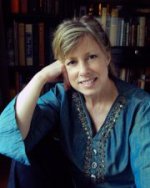
Leslie Ligon
APH Creative Use of Braille Award Winner
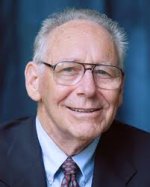
Dr. Richard Woodcock and the Woodcock-Munoz Foundation
Zickel Award for Product Development Winner
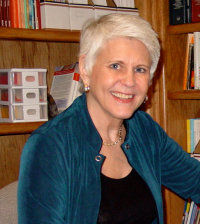
Dr. Lynne Jaffe
Zickel Award for Product Development Winner
11th Annual National Prison Braille Forum Will Highlight Federal Second Chance Act Grants Supporting Braille Production Facilities in Prisons
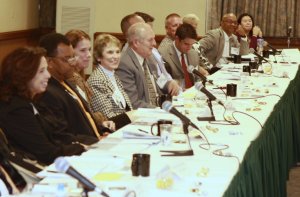
On Wednesday, October 12, APH Public Affairs staff will host the 11th Annual National Prison Braille Forum in Louisville. This day-long gathering, which is held each year in conjunction with the APH Annual Meeting, brings together vision and corrections professionals from across the U.S. to discuss issues related to braille production operations housed in corrections facilities. Typically, several “graduates” of these programs who are now transcribing as a career join the group to offer their unique perspective on reentering the workforce with a new skillset.
In 2011, two federal Second Chance Act grants were awarded to support prison braille programs, and both recipients will present status reports at the upcoming Forum. The Miami Accessible Media Project (MAMP), located in the Miami Correctional Facility in Bunker Hill, IN, received funding to expand accessible media production in the prison’s braille program to include production of large print and electronic files. This project also provides support and equipment to qualified braille transcribers as they leave prison and establish transcription careers on the outside.
The Alternative Media Access Center (AMAC) located in Atlanta, GA, received a grant for a project called PROFITT (Providing Real Opportunities for Income Through Technology). Through this project a curriculum is being developed that will enable offenders in prison braille programs to go from learning braille to establishing careers as transcribers upon release from prison. It will cover information on braille certifications, tactile graphics, software, small business set-up, and more.
Interested Forum participants will tour the KCI Braille Services program at the Kentucky Correctional Institution for Women on Thursday morning, October 13.
Anyone interested in learning about prison braille programs is invited to attend the Forum and participate in the KCI Braille Services tour but pre-registration is required by September 17. To get specific information on the time, location, and agenda for the Forum, or to register for the Forum or the tour, please contact Becky Snider in the APH Public Affairs Department: 800-223-1839 ext. 356, 502-899-2356, rsnider@aph.org.
Getting In Touch With Literacy – And APH Products!
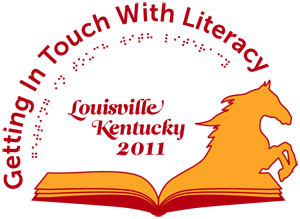
APH is pleased to announce a series of special pre-conference workshops during the Getting In Touch With Literacy conference in Louisville. The workshops will take place Wednesday, December 7, prior to the opening session of Getting In Touch With Literacy.
Training will be offered on the new Braille Plus 18, on Building on Patterns, and on an intervention continuum of APH products for students with multiple disabilities. You will be able to register for these half-day workshops when you register for the Getting in Touch With Literacy conference!
The 2011 Getting In Touch with Literacy Conference will be held in Louisville, December 7 – 10, at the historic Seelbach Hotel. The program will cover topics of interest in early literacy experiences and the expanded core curriculum, response to intervention, assessment for literacy instruction, student and family perceptions of learning braille, and lots more!
More information is available at www.gettingintouchwithliteracy.org.
Successful Summer Webcast Series Archived
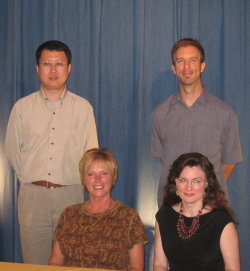
Clockwise from upper left: Yan Zhang, Anthony Slowinski, Karen Poppe, and Jayma Hawkins
Over 1200 viewers can’t be wrong!
Four web presentations, along with a live Q&A session, are now archived on the APH website. This series called Braille Transcriber and Teacher Training included a web presentation called Important Tactile Skills for Literacy by Karen Poppe, Tactile Graphic Project Leader. Karen demonstrated numerous APH Tactile Graphic products and how to use them to teach tactile skills to early learners.
Yan Zhang, Tactile Graphic Designer, presented Key Elements When Designing Tactile Graphics. Yan discussed the basic principles of designing quality tactile graphics giving examples, suggested materials and a useful list of resources.
Anthony Slowinski, Tactile Graphic Designer, presented Tactile Graphic Image Library + Graphic Freeware = Meaningful Cost Efficient Graphics. Anthony demonstrated how to use the Library with freeware called Inkscape – making the image library useful to users who do not have expensive drawing software. He demonstrated how to download images from the TGIL and customize them with Inkscape.
The fourth webcast presented the results of an APH Survey on Consumable Textbooks and Materials called What Is a Consumable Textbook? by Jayma Hawkins, Accessible Media Editor. This presentation reviewed the results of a survey answered by transcribers and teachers that will give us a better foundation to create guidelines for transcribing consumable materials.
All of these web presentations can be found at archive.aph.org/training/.
If there are other topics that you would be interested in seeing presentations about, please feel free to contact us at info@aph.org.
LouisPlus has Launched!
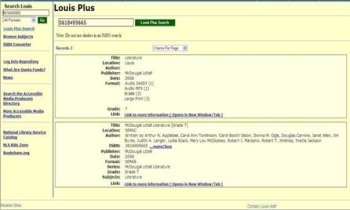
We are excited to share with you that LouisPlus–the single search for the Louis Database and NIMAC—is now live! You will now see the LouisPlus link just to the right of the Louis search box on the Louis home page at: http://louis.aph.org.
LouisPlus allows you to do one search to locate accessible instructional materials in either Louis or NIMAC, and NIMAC authorized users will be pleased to know that they can click a link within the search results to go directly to the NIMAC record and download the file or assign it to an Accessible Media Producer.
As a reminder, the NIMAC contains NIMAS source files that may be used to create accessible instructional materials. Louis lists instructional materials in student-ready accessible formats. For more about NIMAC please visit www.nimac.us.
Please call Resource Services at 800-223-1839 ext. 705 for more information on LouisPlus.
New Museum Exhibit Focuses on APH’s Partnership with the Federal Government
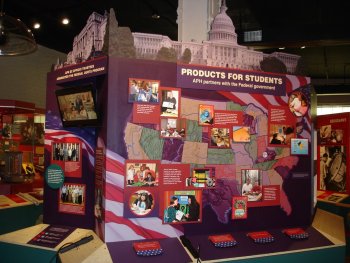
The APH Museum’s newest addition is an exhibit completed in June called “Products for Students: APH Partnership with the Federal Government.”
The foundation of APH’s service to people who are blind and visually impaired – particularly to students working below college level – is our collaborative relationship with the Federal government. That arrangement began in 1879 with passage of The Act to Promote the Education of the Blind. APH receives a Federal appropriation each year to develop educational tools and materials, and to make these products available to qualifying students. This national responsibility is the core of our mission.
“Products for Students” explains how the Federal Quota Program works, beginning with the annual census taken of the students we serve, and the critical role that Ex Officio Trustees across the country play. Three brief videos featuring elected officials, students using APH products (President Michael Bina and Maryland School for the Blind students), and Ex Officio Trustees (Lou Tutt, Leslie Durst, and Nancy Niebrugge), reinforce the importance of our collective partnership for quality educational opportunities.
Historic Piano Finds a Home at APH
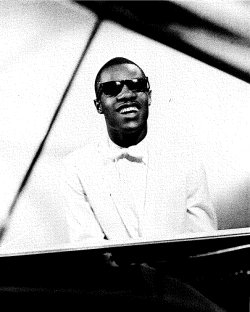
A senior portrait of Stevie playing the school piano
A moving company from Michigan delivered a unique artifact to the APH Museum in July, a piano from the Michigan School for the Blind. The school opened in Lansing in 1880 and was closed by the state in 1995 due to declining enrollment. The Steinway baby grand from the school auditorium would have been used by many students, including their most famous graduate, Steveland Morris, better known to the world as mega-entertainer Stevie Wonder. A photograph in Ted Hull’s 2000 memoir The Wonder Years shows Wonder and other musicians around the piano, ca. 1965, during a “jam session.” This spring, APH Ex Officio Trustee Collette Bauman, who is with Michigan’s Department of Education Low Incidence Outreach, contacted APH about finding the famous piano a new home.
“I thought it would be a good place to share one of our treasures,” said Bauman.
Installing the piano will require some planning. A section of the museum between the story of talking books and Helen Keller is currently being evaluated. Museum Director Mike Hudson has already been in touch with Hull, a MSB graduate who was Wonder’s private teacher and companion between 1963 and 1969. Wonder’s constant absences from his public school had put him in hot water with both his mother, Lula, and the Michigan Department of Education. His enrollment at MSB and the hiring of Ted Hull solved that problem for Motown Records neatly. Also, we’re learning about the role of Helen “Peggy” Traub, a teacher at the Kentucky School for the Blind who was originally hired to tutor Wonder when he performed in Louisville in 1963. Stay tuned as we work to develop and install this fascinating story.
New APH and Dolly Parton’s Imagination Library Page
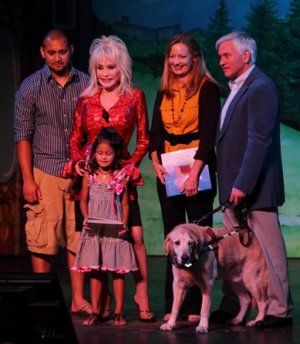
Bradley Burkett (dad), Dolly Parton, APH’s Suzette Wright and Gary Mudd (with Denver), and Cameron Burkett.
Check out this new webpage and learn the latest on this exciting new literacy partnership. Just posted – video of the partnership announcement with Dolly Parton, Foundation President David Dotson and APH’s Gary Mudd at Dollywood!
Field Testing Opportunity!
APH seeks field test sites for a storybook about a child who goes to camp and learns about sports. The book is written at fourth grade level. A CD with an html version of the book is included with both the large print book and the braille book. Field test sites need to evaluate both hard copy and electronic versions. Field testing begins in October. If interested, e-mail tpierce@aph.org.
NFB Youth Slam Exhibit
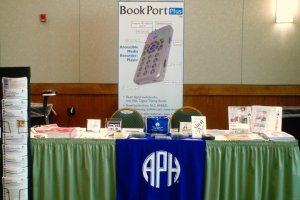
APH’s booth stayed busy with interested and inquisitive youth from around the country at the National Federation of the Blind Youth Slam in Baltimore, MD. The exhibit took place on July 20. APH Field Services Representative, Kerry Isham showed STEM-related APH products (Science, Technology, Engineering, and Mathematics) to approximately 200 enthusiastic students. Attendees showed particular interest in the APH Talking PC Maps, the Book Port Plus, Refreshabraille 18, the Orion TI-36x Talking Scientific Calculator, the braille business card Impressor, and the Life Science Tactile Graphics.
ACB 50th Anniversary Conference Presentation
Field Services Representative, Kerry Isham presented on the topic of “Lighting for Low Vision Individuals” at the 50th Annual National Conference and Convention of the American Council of the Blind in Reno, NV, on July 14. Kerry discussed research by APH low vision project leader, Elaine Kitchel, concerning appropriate use of color, the electromagnetic spectrum, and how to choose correct lighting for work and home. The eager participants asked many questions and engaged in animated discussion. At the conclusion of the presentation, the approximately 30 attendees took part in an interactive exercise, during which they developed plans for the lighting of a new home.
APH at the American Association of Deaf-Blind National Symposium
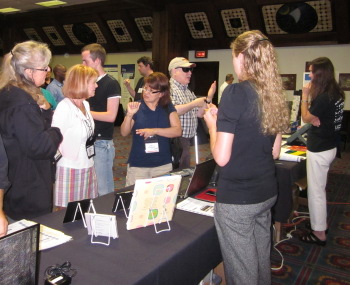
The American Association of the Deaf-Blind (AADB), a nonprofit, national consumer organization of, by, and for deaf-blind Americans and their supporters, held their 2011 National Symposium in Ft. Mitchell, KY, June 19-24. With over 600 consumers, professionals, and family members in attendance, Sandi Baker and Tristan Pierce, APH Research Project Leaders, along with Cathy Johnson, Field Services Representative, stayed busy at the APH exhibit booth throughout the conference greeting attendees, sharing information about APH and products, and answering questions. Of particular interest were the Refreshabraille 18, the Draftsman Tactile Drawing Board, and Brailleable Labels and Sheets. Being present at the symposium also allowed APH the opportunity to become acquainted with this consumer group and obtain information regarding consumer needs and possible product ideas.
From the Museum: Is the “W” in Braille Logical?
We often explain the Braille System by showing how Louis Braille arranged the alphabet into rows of ten. The first row only uses the top two rows of the cell and covers the letters a-j. The second row adds the three dot to a-j to create k-t. And the third row adds dots 3 and 6 to a-j to create the remaining letters. The symbol for “W” does not have the three dot, and is obviously out of order. We often say that there was no “W” in French and that the symbol for “W” was added later.
Note that there is a more interesting and correct answer to the question of why “W” does not follow the logic of Braille’s system. Actually, the “W” was there from the beginning, at least it is included in the first publication of the system in 1829. But it was in the Fourth Row of symbols. That row adds only the 6 dot to a-j and covers nine symbols common to French but not normally used in English, mostly accented vowels. At the end of the fourth row, basically a “J” with the 6 dot added, is the “W.” “W” appeared in French only in borrowed words from English and German, so Braille delegated it to a lower priority role. But it was not added later, it was just very uncommon in French, so was accorded a less important position in his table of symbols.
Oldies but Goodies: The "Established" APH Product Series
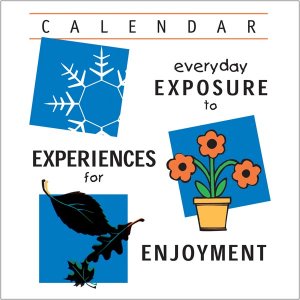
The Everyday Exposure to Experiences for Enjoyment Calendar, also called the Everyday Activities Calendar, was written by Nancy Smith, a Wisconsin state-wide consultant for children who are blind or visually impaired and produced by APH in 2001. It is an idea-filled calendar that suggests a fun preschool activity for each day of the year. The calendar was designed specifically for young (ages 3-8) visually impaired children, but all children may benefit from and enjoy participating in the activities. The activities are drawn from everyday occurrences in a child’s life and make use of easily accessible, low cost materials typically available in the home. The large print/braille calendar comes in a three-ring binder with a colored dividing page between each month. The calendar is formatted with two days per page. This calendar does not track any specific year, and can therefore be used year after year.
The introduction for this product includes detailed task analyses of washing the dishes and of crushing crackers for meat loaf stuffing. These are provided in order to demonstrate examples of how to break an everyday experience down into the smaller steps that make up the experience. Because visual impairment results in a deficit of learning through visual observations and it is necessary to use a multisensory approach that takes advantage of the child’s remaining senses. Activities may need to be broken into smaller segments and repeated multiple times.
Examples of some of the everyday experiences that are included in this calendar are:
“What is a salad? Help make one for dinner.”
“Use an alarm clock to wake up.”
“Pick all the nickels from a pile of coins and buy something with them.”
“Find pairs of things, like shoes, socks, and dishes.”
“Visit a vegetable garden. What’s growing there?”
It is not required that every activity in the calendar be completed, but rather, the calendar is meant to be a compilation of ideas from which to draw inspiration and expand upon. The calendar is designed so that the user may begin at any point and choose activities appropriate for the child, the occasion, and the lifestyle of the family. Cross-environmental teaching is encouraged and activities may be taught by a variety of different “teachers” and in a variety of locations.
If you have any suggestions for other products you would like to see highlighted in this monthly feature, please send your comments to Monica Turner at mmturner@aph.org.
The Mother of Rehabilitation Teaching — “In the House”
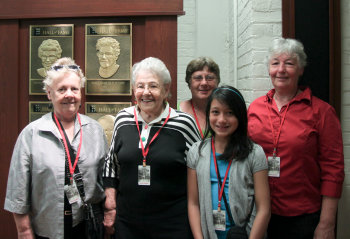
Pat Junkin, Alice Raftary, Debi Junkin (Pat’s daughter), Alice’s granddaughter Hanna Tyquiengco from Guam, and Mary Raftary (Alice’s daughter).
The legendary Alice Raftary, 2002 Hall of Fame for the Blindness Field inductee, spent a day with us recently and we are much the better for it. On Monday, July 11, Alice, along with family and friends, graced us for much of the day. Alice’s enthusiasm for the Hall and for APH was contagious. She and the group, including her 12-year-old granddaughter Hanna who was here from Guam, first toured the plant, then the Museum, finishing with the Hall of Fame. After lunch, Alice spent the afternoon visiting and sharing with various APH staff members. We were honored with a very special day!
Want to learn more about Alice and her contributions to our field? Visit her biography page on the Hall of Fame website.
"Like" APH at Our Facebook Page!

We invite you to visit our Facebook page and "Like" us! You can find APH at these social media sites: Twitter, YouTube, Flickr, and at our blog, Fred’s Head from APH.
http://www.facebook.com/pages/American-Printing-House-for-the-Blind/122879984400686
HELP WANTED – MATH SPECIALIST
Florida School for the Deaf and the Blind
St. Augustine, FL
Contact: 904-827-2325 or email buccaa@fsdb.k12.fl.us on or before August 12.
APH Travel Calendar
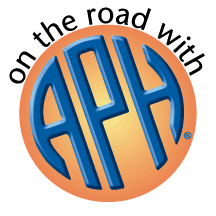
August
August, 2011
Building on Patterns Workshop;
Baton Rouge, LA
August 6, 2011
American Correctional Association: 141st Congress of Correction; Presentation on Prison Braille Reentry;
Gaylord Palms Resort and Convention Center in Kissimmee, FL
August 8-9, 2011
Infant-Toddler Institute;
Hyatt Regency in Lexington, KY
August 10, 2011
DIAGRAM Annual Meeting;
Washington, DC
August 10-11, 2011
FVLMA Product Training-Region 4 Educational Service Center;
Houston, TX
August 12-14, 2011
AER Regional Conference/MACRT;
Boston, MA
August 16-20, 2011
BVA 2011;
Golden Nugget Hotel in Las Vegas, NV
September
September 21-24, 2011
Envision 2011;
Hilton St. Louis at the Ballpark in St. Louis, MO
September 25, 2011
Indiana Vision Expo;
Main Library in Indianapolis, IN
October
October 13-15, 2011
APH Annual Meeting;
Galt House in Louisville, KY
October 19-21, 2011
Northern Rockies AER 2011;
Sun Valley, ID
November
November 3-5, 2011
ATIA 2011;
Renaissance Schaumburg Hotel & Convention Center in Schaumburg, IL
November 10, 2011
West Virginia School for the Blind Conference;
Romney, WV
November 30-December 2, 2011
North Carolina Assistive Technology Expo-20th Annual (NC AT Expo 2011) at the North Raleigh Hilton;
Raleigh, NC
December
December 7-10, 2011
Getting In Touch With Literacy Conference 2011;
Louisville, KY
Sizzlin’ Summer Savings Sale
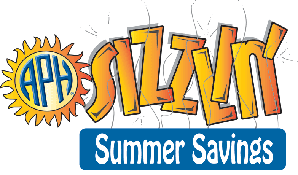
Load up a world of savings on selected APH products with APH’s Sizzlin’ Summer Savings Sale 2011, July 1—September 30. As always, first come, first served.
New Downloadable Manuals Available

Get the manual you need instantly! APH offers a selected list of product manuals available for free download (archive.aph.org/manuals/). You may print or emboss these as needed. We will continue to package hard copies of these manuals with their products and sell hard copy replacements.
Newly added manuals include:
- Talking Cooking Thermometer, text file, 1-03992-00
- The Wilson Digital Recorder, text file, 1-03993-00
- Life Science Teacher’s Guide, Braille, 61-151-212
- Braille Connection Teachers Edition, Braille, 5-11101-00
- Notes to Reader Alphabet Scramble, Braille, 5-01198-00
- Color Beam Book, Braille only, 5-08390-00
NEW! Sudoku Partner 6×6
1-03719-00 — $62.00

Finally a tactile sudoku – have fun while exercising your brain!
Sudoku Partner 6×6 is a portable, reusable board for setting up and solving 6×6 sudoku puzzles. Its advantage over other sudoku solving boards is that it allows you to mark possible answers in each box to help you keep track of them, without hundreds of separate pieces. It is also useful for those who don’t know braille but still want a tactile system for solving the puzzles.
Like a standard print sudoku puzzle, the board has an array of small and large rectangles. The small ones are called boxes and the large ones are called blocks. Each block is made up of six boxes—three boxes across and two boxes high. Tactually, the boxes are outlined in smooth raised lines and the blocks in heavier dashed lines.
Classroom teachers using sudoku in school may want to take steps to introduce students thoroughly to the solving board and the terminology before jumping straight into solving puzzles. It is especially important to make sure students can track left to right, up and down, and at the same time look for information tactually. Building success through gradual steps should keep the activity enjoyable for students, too. For these reasons, the booklet that comes with the kit includes a suggested teaching progression.
Includes:
- Two puzzle-solving boards
- Booklets with rules, examples, and puzzles in print and braille
- 150 puzzles provided with answers, at three difficulty levels
Recommended ages: 10 years and up.
NEW! EZ Track Calendar, 2012
1-07900-12 — $33.50
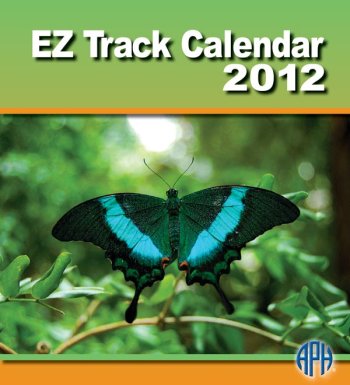
EZ Track is a multi-faceted line of low vision products to help you get organized…and stay that way!
Designed for people with low vision, EZ Track products utilize large print of at least 18 points, easy-to-use binder formatting, and special accessories as aids in organizing important day-to-day activities. There are four products in the EZ Track series: Address Book, Calendar, Financial Record Keeper, and Medical Record Keeper.
The EZ Track Calendar offers a systematic and organized way of keeping track of appointments, holidays, and other events. Each large print page holds four days, with enough room to write notes and appointments. The calendar comes with a three-ring binder.
APH offers a number of recreational books in braille (Quota funds can be used). Each of these titles was originally transcribed and produced by APH for the National Library Service which has graciously granted permission for this offering. As usual, these titles have been added to the APH Louis Database where you can find thousands of titles produced in accessible formats.
Note: all books are produced upon receipt of orders, therefore, please allow several weeks for delivery.
Eve of the Emperor Penguin: Magic Tree House, Book #40
Mary Pope Osborne: T-N1832-80 — $19.50
The Magic Tree House whisks Jack and Annie away to the super-cold continent of Antarctica, the home of penguins, to search for the fourth secret of happiness for Merlin. Grades 2-4. *(AR Quiz #125558, BL 3.7, Pts. 2.0)
A Life in the Wild: George Schaller’s Struggle to Save the Last Great Beasts
by Pamela S. Turner: T-N1834-00 — $28.50
Examines the background and fieldwork of wildlife conservationist George Schaller. Discusses his first Alaska expeditions and experiences observing gorillas in the Congo; studying tigers in India, lions in East Africa, and snow leopards in the Himalayas; and tracking pandas and surveying other endangered animals in China. Grades 5-8. *(AR Quiz #126303, BL 7.2, Pts. 4.0)
When Worlds Collide
by Philip Wylie: T-N1834-50 — $135.00
Two planets, Bronson Alpha and Bronson Beta, hurtle through space on a collision course with Earth. Scientist Cole Hendron secretly recruits fellow scientists to construct a powerful, Noah’s ark-inspired spacecraft to evacuate a select few people before the inevitable cosmic disaster. Includes sequel After Worlds Collide.
Creating a World Without Poverty: Social Business and the Future of Capitalism
by Muhammad Yunus: T-N1850-00 — $93.50
Muhammad Yunus, Nobel Peace Prize winner and founder of Bangladesh’s Grameen Bank, explains "social business" as enterprise created to serve the poor. Proposes using capitalism to tackle poverty, pollution, and inadequate health care and education in developing countries. Advocates access to global television and news services for impoverished populations.
Up At the College
by Michele Andrea Bowen: T-N1846-90 — $88.00
When forty-three-year-old Yvonne Fountain’s husband tosses her and their daughters out, Yvonne trusts the Lord and returns to Durham, North Carolina, to teach at a black university. Yvonne acknowledges an attraction to former classmate and coach Curtis Parker, but she wants a God-fearing man and Curtis enjoys his bachelorhood.
*Accelerated Reader quiz number, book level, and point value. For more information on the Accelerated Reader program, see the January 2006 APH News or www.renlearn.com/ar/
APH News Credits
President:
Dr. Tuck Tinsley
ttinsley@aph.org
Designer:
Malcolm Turner, APH Website Coordinator
webmaster@aph.org
Thanks to the following APH staff:
- Cindy Amback, Support Specialist, Field Services
- Janie Blome, Director, Field Services
- Scott Blome, Director, Communications
- Kerry Isham, Field Services Representative
- Micheal Hudson, Director, APH Museum
- Nancy Lacewell, Director, Government Relations
- Stephanie Lancaster, Graphic Designer, Communications
- Julia Myers, Director, Resource Services
- Cathy Johnson, Field Services Representative
- Artina Paris-Jones, Assistant, Field Services
- Jane Thompson, Director, Accessible Textbooks
- Monica Turner, Field Services Representative
Editor:
Bob Brasher, Vice President, Advisory Services and Research
bbrasher@aph.org
Read our blog: Fred’s Head from APH.
For additional recent APH News, click the following:
July Issue – archive.aph.org/news/july-2011
June Issue – archive.aph.org/news/june-2011
May Issue – archive.aph.org/news/may-2011
Archive of all previous issues – archive.aph.org/news/archive
The APH News is a monthly publication from the American Printing House for the Blind:
1839 Frankfort Avenue
Louisville, KY 40206
800/223-1839
Please share this web link or any items that appear in this publication with anyone who might benefit.
Thank you.
Subscribe to the APH News!
Get convenient email reminders every month when a new issue of the APH News is released.
It’s Easy!
- Create an email to aphinfo-request@iglou.com
- Leave the subject blank
- Type the word ‘subscribe’ (without any quote marks) in the body of the message
- Send it.


